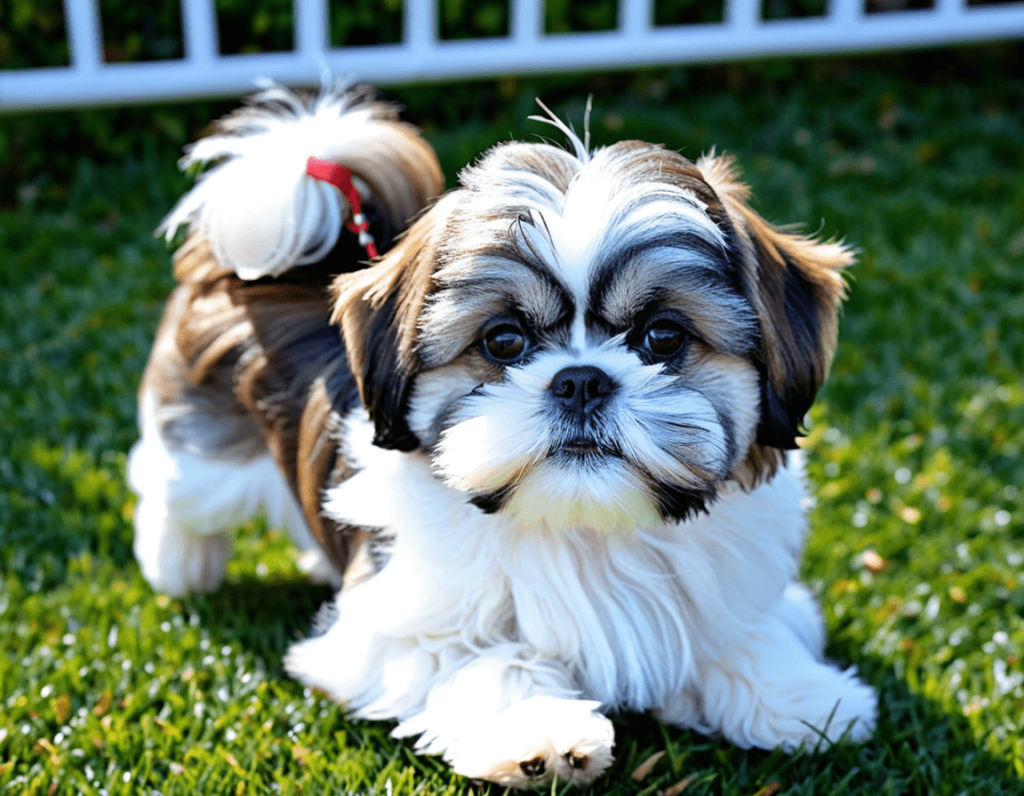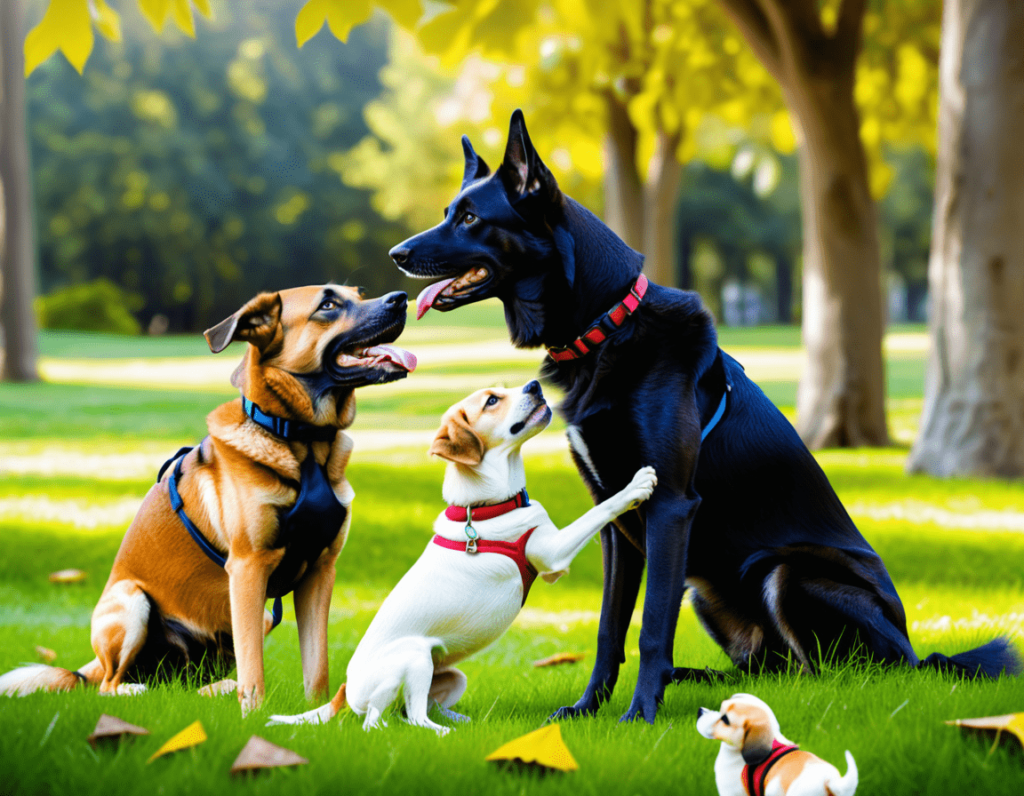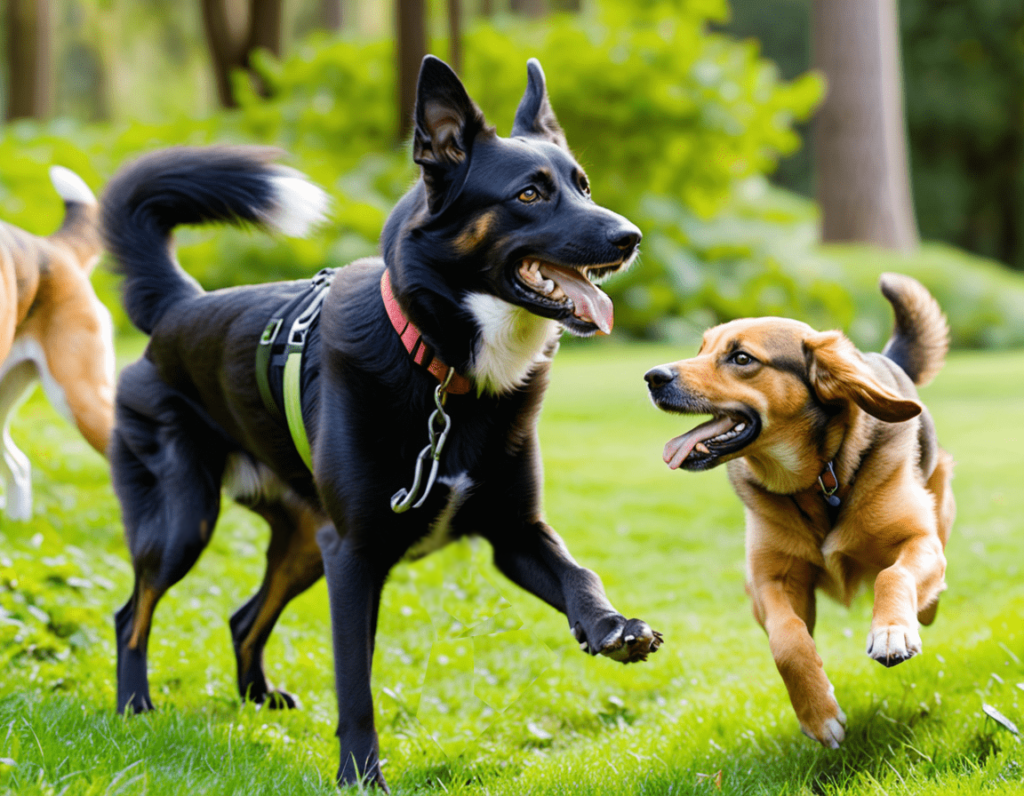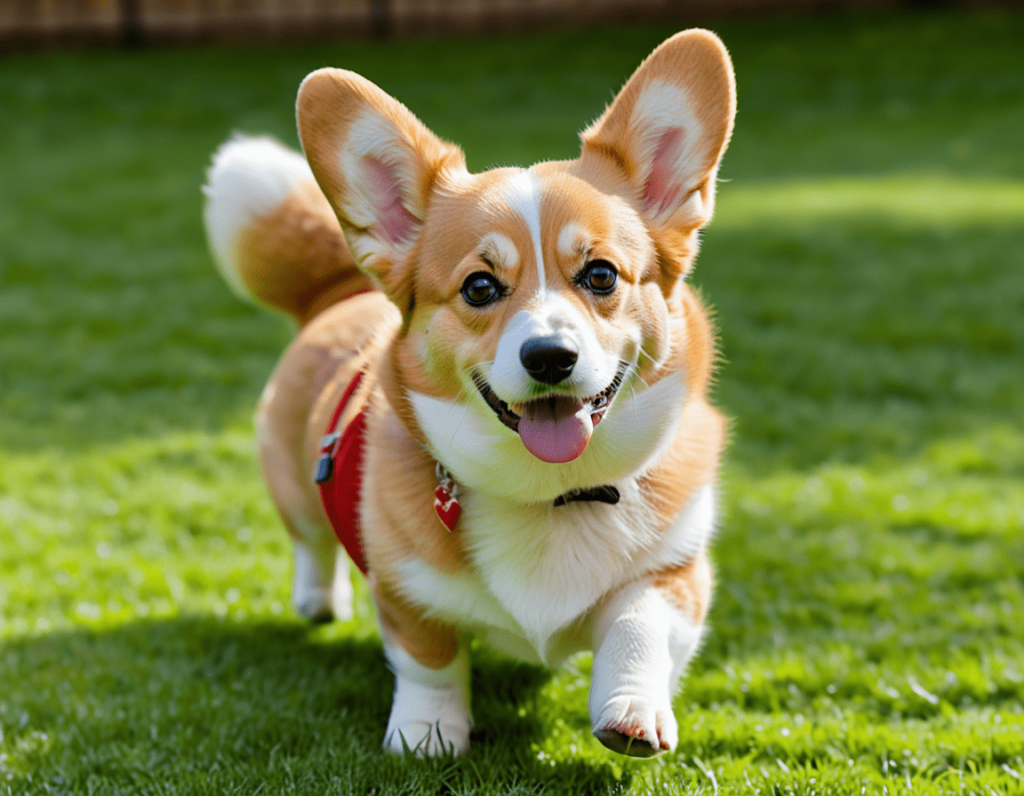
If you’ve ever watched a group of dogs play at the park, you might have noticed something interesting: they seem to have their own little world, complete with hierarchies and social rules. This phenomenon is known as “dog pack mentality.” In this article, we’ll break down what it is, why it matters, and how you can use this knowledge to improve your relationship with your furry friend. Grab a snack (preferably not a dog biscuit), and let’s dive in!
What is dog pack mentality?
If you’ve ever watched a group of dogs play at the park, you might have noticed something interesting: they seem to have their own little world, complete with hierarchies and social rules. This phenomenon is known as “dog pack mentality.” In this article, we’ll break down what it is, why it matters, and how you can use this knowledge to improve your relationship with your furry friend. Grab a snack (preferably not a dog biscuit), and let’s dive in!
The Hierarchy of Dogs
In any dog pack, there are typically dominant and subordinate members. The dominant dog (often referred to as the “alpha”) is not necessarily the biggest or the toughest; it’s more about confidence and leadership qualities. You might even find that your tiny Chihuahua believes he’s in charge, barking orders at your Great Dane. Talk about a classic underdog story!
Why Does It Matter?
Understanding dog pack mentality is crucial for dog owners. When you recognize how your dog perceives their place in the social structure, you can train and socialize them more effectively. Plus, knowing their pack instincts can help you avoid some common behavioral issues. For example, if your dog is trying to assert dominance, you might want to work on some obedience training—unless you want your living room to become a doggy wrestling arena.
Socialization: The Key to Happy Pups
Socialization is all about helping your dog learn how to interact appropriately with other dogs and people. This is especially important for puppies, who are like little sponges soaking up information about their social world. The more positive interactions your pup has, the better they’ll be at navigating the doggy hierarchy without trying to take over the world (or at least your sofa).
Tips for Socializing Your Dog
- Start Early: Puppies are more adaptable and learn quickly, so early socialization is key. Think of it as sending your pup to “doggy daycare,” minus the expensive tuition fees.
- Positive Experiences: Ensure that your dog has positive experiences with other dogs and people. Treats and praise can go a long way. Remember, a happy dog is less likely to think they’re the boss of everything (including you).
- Control the Chaos: Sometimes, introducing too many new dogs at once can overwhelm your pup. Start with one or two friendly dogs, and gradually increase the numbers—like a well-planned party, but without the awkward small talk.
Socialization: The Key to Happy Pups
Socialization is all about helping your dog learn how to interact appropriately with other dogs and people. This is especially important for puppies, who are like little sponges soaking up information about their social world. The more positive interactions your pup has, the better they’ll be at navigating the doggy hierarchy without trying to take over the world (or at least your sofa).
Tips for Socializing Your Dog
- Start Early: Puppies are more adaptable and learn quickly, so early socialization is key. Think of it as sending your pup to “doggy daycare,” minus the expensive tuition fees.
- Positive Experiences: Ensure that your dog has positive experiences with other dogs and people. Treats and praise can go a long way. Remember, a happy dog is less likely to think they’re the boss of everything (including you).
- Control the Chaos: Sometimes, introducing too many new dogs at once can overwhelm your pup. Start with one or two friendly dogs, and gradually increase the numbers—like a well-planned party, but without the awkward small talk.

Leadership and Training
As the human in the relationship, it’s essential to establish yourself as the leader of the pack. This doesn’t mean you need to wear a crown or have a scepter (though, who wouldn’t want to?). Instead, focus on consistent training and clear boundaries. Your dog should understand that you’re in charge—especially when it comes to the treat jar.
Training Techniques to Consider
- Positive Reinforcement: Reward good behavior with treats and praise. Think of it as a motivational speech, but instead of standing on a podium, you’re giving them a delicious snack.
- Consistency is Key: Use the same commands and rules for your dog every time. Imagine if your boss changed your job description every week—confusing, right? Your dog feels the same way.
- Lead by Example: Be calm and confident in your interactions. If you’re anxious about a new dog approaching, your pup will pick up on that and might react accordingly. Channel your inner dog whisperer!
The Importance of Play
Playtime is an essential part of a dog’s life and a significant aspect of their social structure. Engaging in play helps dogs bond with each other and establish their social status. It’s like a team-building exercise, but with more barking and less trust falls.
Types of Play
- Interactive Play: Games like fetch or tug-of-war help build a strong bond between you and your dog. Just remember, winning every tug-of-war match might lead your dog to believe they’re the reigning champion of the household.
- Group Play: If your dog enjoys being around other dogs, consider finding a local dog park or joining a dog playgroup. Just be prepared for the occasional game of “Who Can Steal the Frisbee First?”
Wrapping Up
Understanding dog pack mentality can significantly enhance your relationship with your furry friend. By recognizing their social instincts and establishing yourself as a leader, you can create a happy, balanced environment for your pup. Remember, a well-socialized dog is less likely to think they run the show—and more likely to be your loyal companion.
So, the next time your dog gives you that “I’m the alpha here” look, just smile and remind them that they may have been the king of the park, but at home, you’re the one holding the remote. After all, who else is going to binge-watch that new series with them?
Common Misconceptions About Dog Pack Mentality
As we dive deeper into the world of dog pack mentality, it’s essential to address some common misconceptions that can lead to confusion among dog owners. Let’s bust a few myths while keeping things light-hearted!
Myth 1: The Alpha Dog Theory
One of the most persistent myths is that every dog pack needs an “alpha” dog to establish control. While it’s true that dogs do exhibit social hierarchies, the notion that there’s always a dominant leader is oversimplified. In fact, many dogs thrive in a cooperative environment where they can socialize without the pressure of a strict hierarchy. So, if your dog is more of a “team player” than a “lone wolf,” that’s perfectly normal!
Myth 2: Dominance Equals Aggression
Another misconception is that a dominant dog is always aggressive. In reality, many dogs exhibit dominant behaviors without being aggressive. Dominance can manifest in playful ways, like claiming the best spot on the couch or stealing the last bite of pizza (yes, they really believe they deserve it!). Understanding these nuances can help you better interpret your dog’s behavior and respond appropriately.
Myth 3: All Dogs Need a Pack
While dogs are social animals, not every dog thrives in a pack environment. Some may prefer their solitude or only want a close bond with their human companions. If your dog isn’t keen on mingling with others, don’t stress! Just like us, dogs have their own personalities and preferences. Embrace your pup’s uniqueness—who knows, they might just be the introvert of the dog world!
The Role of Genetics in Pack Mentality
Interestingly, genetics also plays a role in a dog’s pack mentality. Different breeds have varying social structures based on their history and original purposes. For example, herding breeds like Border Collies may exhibit strong pack instincts due to their ancestry as working dogs, while a laid-back breed like the Bulldog might not feel the need to assert themselves as much.
When choosing a dog, it’s essential to consider their breed traits and how they might influence their behavior. If you adopt a breed known for strong pack instincts, be prepared for a dog that thrives on socialization and interaction. It’s like bringing home a new family member who loves hosting parties!
Interestingly, genetics also plays a role in a dog’s pack mentality. Different breeds have varying social structures based on their history and original purposes. For example, herding breeds like Border Collies may exhibit strong pack instincts due to their ancestry as working dogs, while a laid-back breed like the Bulldog might not feel the need to assert themselves as much.
When choosing a dog, it’s essential to consider their breed traits and how they might influence their behavior. If you adopt a breed known for strong pack instincts, be prepared for a dog that thrives on socialization and interaction. It’s like bringing home a new family member who loves hosting parties!
Signs of a Well-Adjusted Pack Member
Conclusion: Embrace the Pack Life
So, how can you tell if your dog is thriving in their pack environment? Look for these signs of a well-adjusted pack member:
- Confident Body Language: A relaxed posture, wagging tail, and playful demeanor indicate that your dog feels secure in their social structure.
- Positive Interactions: If your dog enjoys playing and engaging with other dogs (and doesn’t turn into a drama queen when things get too rowdy), they’re likely well-socialized.
- Obedience and Training Response: A dog that listens to commands and engages positively in training is demonstrating respect for their “leader” and understanding their place in the pack.
Understanding dog pack mentality can transform the way you interact with your furry friend and enhance their quality of life. By recognizing their social needs and establishing a nurturing environment, you’ll foster a bond that goes beyond the typical human-dog relationship.
Remember, your dog is not just a pet; they’re a beloved member of your family who thrives on companionship, communication, and—let’s face it—a bit of silliness. So whether your dog is a top dog at the park or just happy being your loyal sidekick, embrace their unique personality and enjoy every moment together. After all, life is better with a wagging tail by your side (especially when it comes to stealing your snacks!).
And don’t forget to check in on those playful instincts—after all, they may just be plotting a coup to take over your couch!

Understanding Dog Pack Mentality: FAQs
1. What is dog-pack mentality?
Dog pack mentality refers to the social behavior and hierarchy that dogs exhibit in groups. Dogs are naturally social animals and often establish a hierarchy within their packs, which can include dominant and subordinate roles.
2. Do all dogs need to be part of a pack?
Not all dogs require a pack environment to thrive. While many dogs enjoy socializing with others, some may prefer a more solitary lifestyle or only desire a close bond with their human companions. Every dog has a unique personality!
3. How can I socialise my dog effectively?
To socialise your dog effectively, start early with positive experiences around other dogs and people. Introduce them gradually to new situations, reward good behaviour with treats and praise, and ensure they feel comfortable in various environments.
4. What are signs that my dog is comfortable in a pack?
Signs that your dog is comfortable in a pack include relaxed body language, wagging tails, playful interactions with other dogs, and a positive response to training commands. A confident dog will usually engage positively with their peers.
5. What should I do if my dog shows signs of aggression in a social setting?
If your dog displays aggression, it’s crucial to intervene calmly and remove them from the situation. Consider consulting a professional dog trainer or behaviorist to help address the underlying issues and work on socialization strategies.
6. Is it necessary for me to be the "alpha" dog in my relationship with my pet?
While establishing leadership is important, it doesn’t mean you need to adopt an authoritarian approach. Building a respectful and trusting relationship through positive reinforcement and consistent training is more effective than trying to assert dominance.
Yes, genetics and breed characteristics can influence a dog’s social behavior. Some breeds, like herding dogs, may have stronger pack instincts due to their history and working purpose, while others may be more independent.
7. How can I tell if my dog is a good pack member?
A good pack member exhibits confident behavior, engages positively with other dogs, and responds well to training commands. If your dog enjoys playtime and socialization without excessive anxiety or aggression, they are likely well-adjusted.
8. What role does playtime have in a dog’s social structure?
While establishing leadership is important, it doesn’t mean you need to adopt an authoritarian approach. BuildinA good pack member exhibits confident behavior, engages positively with other dogs, and responds well to training commands. If your dog enjoys playtime and socialization without excessive anxiety or aggression, they are likely well-adjusted.g a respectful and trusting relationship through positive reinforcement and consistent training is more effective than trying to assert dominance.
Yes, genetics and breed characteristics can influence a dog’s social behavior. Some breeds, like herding dogs, may have stronger pack instincts due to their history and working purpose, while others may be more independent.
10. How can understanding dog pack mentality improve my relationship with my dog?
By understanding dog pack mentality, you can better meet your dog’s social needs, establish yourself as a confident leader, and foster a more harmonious relationship. Recognizing their instincts allows you to create an environment where your dog feels secure and happy.


